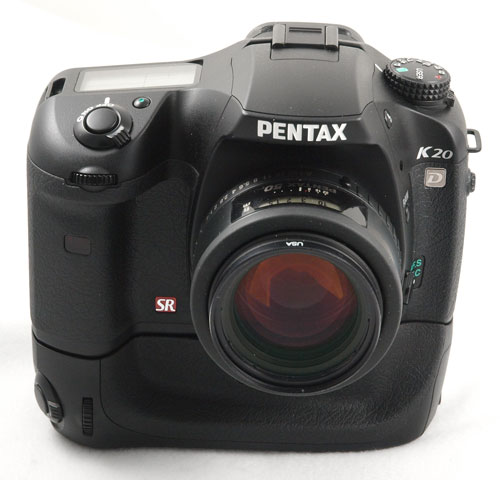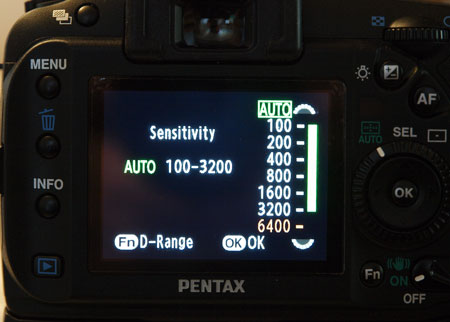Resolution and Image Quality

Our early impressions of the K20D were pretty positive with the fast Pentax 50mm f1.4. As always with recent screw-drive AF, the lens focusing is reasonably fast (if not blistering) and noise is much greater than the excellent Canon Ultrasonic motor lenses - which are now most of the better lenses in the Canon line. We had a K10D for comparison and the K20D seemed faster in AF, even though Pentax makes no claim of improvements in AF with the K20D.
The 14.6 MP CMOS sensor actually allows an ISO Boost to 6400, so the new ISO 3200 and ISO 6400 were the next features to tackle. By default the K20D high ISO noise reduction is set to off. This resulted in usable but grainy images at ISO 3200 and an ISO 6400 performance that was too coarse to be useful for our needs.

However, with the "weakest" and "weak" high ISO Noise Reduction settings, our first impressions in pixel-peeping high ISO images was much more favorable. The images with a small amount of noise reduction were pretty good - much better than we had expected. We had to wonder if early reviewers had noticed that high ISO noise reduction is completely off by default.
Images to ISO 1600 were quite good; 3200 shows deterioration in the shadow areas, but it is still very usable - even for large prints. ISO 6400 quality is better with a little NR and it would be usable for smaller prints or the web-posting we do, but too much is lost for large prints. All in all this is an outstanding performance for the new Samsung 14.6 MP sensor. Like many others, we wondered how good a new sensor from Samsung could be compared to Canon, Nikon, and Sony. More testing will be done in this area, but our first impressions are that the Samsung sensor is quite competitive, capturing more detail than the competing Nikon, Sony, Olympus, and Canon prosumer models.

Auto can be set to any ISO range you want, a feature Canon still refuses to implement fully. Based on early test shots we wouldn't hesitate to set the auto range from 100-1600 on a routine basis and 100-3200 if we were going into a low-light situation - or for times when the highest possible shutter speed is required. We would reserve 6400 for those special situations where the trade-offs make it worthwhile.
Whenever there is a recent Pentax is in our hands, we are again reminded of the usefulness of Hyperprogram, where you can instantly shift the aperture or shutter speed (front and rear dials) with the camera shifting other program parameters. Like the K10D, the K20D continues the unique TAv (Time & Aperture) Priority program, where you can select the shutter speed and the aperture which remain fixed while the program dynamically changes the ISO to maintain shutter speed and aperture. Selectable Auto ISO to 6400 on the one hand, and both TAv and Sv (Sensitivity or ISO) programs with the same range on the other hand, make the K20D a remarkably flexible digital SLR.










50 Comments
View All Comments
Tridion - Sunday, March 23, 2008 - link
Here is also some high iso images:http://highiso.net/images.php?Sort=isospeedratings...">http://highiso.net/images.php?Sort=isospeedratings...
Justin Case - Sunday, March 16, 2008 - link
As usual, we get a lot of specifications lifted from the camera's brochure, and a lot of images of the camera, but not a single photo taken with the camera. This is like reviewing Doom 4 by posting pictures of the box and DVD instead of screenshots from the game...shira - Wednesday, March 12, 2008 - link
Does the K20D have any special provision for cleaning the CMOS? A friend of mine with the Canon IDs Mark II (approximately same megapixel count as the K20D, though with a full-screen CMOS) complains how time-consuming it is to clean the CMOS on the camera, which becomes increasingly important as image quality increases. Canon has now implemented a "shake" function to clean the CMOS on the MK III version of the IDs, which represents a real time-saver. Does the K20D have a similar function?benplaut - Wednesday, March 12, 2008 - link
First of all, it has a "sensor shake," as do many newer camera (my K10D has this, too). Second, it has an anti-static coating over the lowpass, which does quite a bit of good. Finally, it has sticky spots around the mirror box to catch dust as it is shaken off--not sure how effective it all is, but I've yet to have a single dust spot on my K10D in three months of owning it. Of course, welded dust still needs to be wet cleaned.Kiwaiti - Friday, March 14, 2008 - link
Sensor shake is ideally suited to the Pentaxes because their sensors are positioned magnetically for the in-body shake reduction. I think my K20D shakes its sensor even more violently than K10Ds I've tried.In case manual cleaning is still necessary, there is a new feature on the K20D showing an image of the sensor with a representation of the surrounding mount as you see it when cleaning, the sensor showing black spots for dust on a white background. The dust map is also saved to a separate folder on the SD card.
gar655 - Tuesday, March 11, 2008 - link
The 17-55IS is NOT $1300. It's about $800, which is in line with the price of the 16-50 Pentax and Oly 12-60. It is not built as well as either, nor is it weather sealed.It is, however, much better optically than the Pentax 16-50 and as good or better than the Oly.
That said, the K20 looks like a great camera for the price, especially for landscape and portrait work.
Wesley Fink - Tuesday, March 11, 2008 - link
We went deeper than a cursory check of lens prices for this reply. Amazon.com is normally competitive with the the best legitimate price for lenses, and they are now $1100 for the 17-55mm IS. We also checked B&H which is currently $999. BTW B&H sells the Pentax for $699 and Amazon sells the Pentax for $679. With those prices we have changed the price for the Canon lens in our review to $1000.Since reviews of the Olympus 12-60mm have proclaimed it the lowest distortion zoom of its type ever tested your conclusion that the Canon is better optically sounds like wishful thinking. The Pentax lens is extremely sharp but it does have more distortion than the 17-55mm Canon, however, so we would likely accept your claim that the 17-55mm IS Canon is better optically. As you point out, though, it is not weather-sealed or built as well as the Pentax or Olympus lenses.
Hulk - Tuesday, March 11, 2008 - link
This Megapixel race in dSLR's is concerning me. This isn't a numbers game but a image quality issue.Please show some 100% crops of this Pentax verses the 40d and some other C sized sensor cameras. Please use prime lenses at F/8 to try and minimize lens variation effects.
Let's see how good this camera is on a per pixel basis.
haplo602 - Wednesday, March 12, 2008 - link
I would disagree, pisel peeping does not help much.It's the final print that matters, so you need to select a target print size and use the same printing technology and equipment for all contenders, then you can compare.
The megapixel race is a bit meh if it is not coupled with NR and dynamic range improvements to utilise the new resolution to the fullest.
Hulk - Wednesday, March 12, 2008 - link
I am not a pixel peeper. Great photography is about composition, light, shadow, and conveying emotion to the viewer. It's not about technology.But this camera review is about technology. I would like to see full scale comparisions as well but unless we look on a per pixel basis we don't know if the increases in sensor technology is keeping up with the mad race to advertise more pixels.
My money is hard earned and I'd like to see the pixels.
Plus I'm quite sure doing a comparision at equal size prints will show virually no difference until print sizes are large enough to start to discern pixels anyway. Then we'd be pixel peeping again!
The point of higher pixel count is increases resolution at higher print sizes right? So let's get to it and see at per pixel? I'm willing to be objective but I'd like to see both tests.